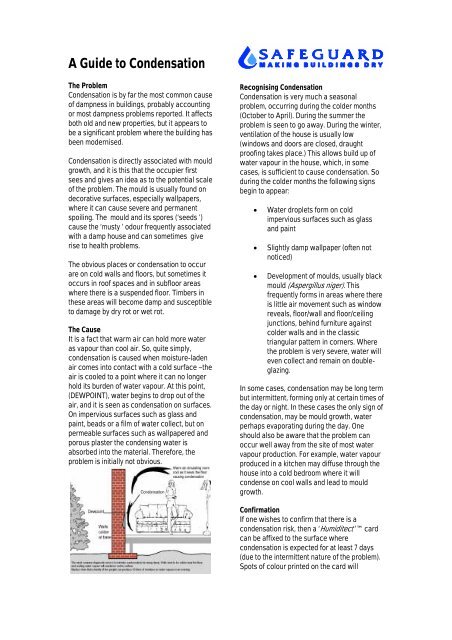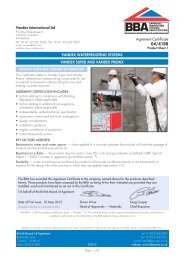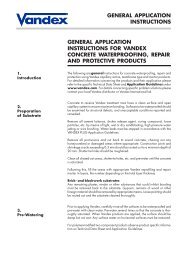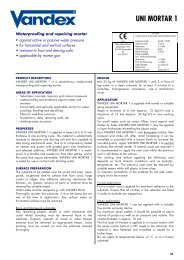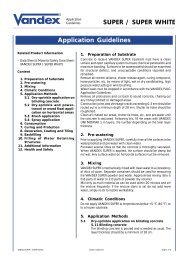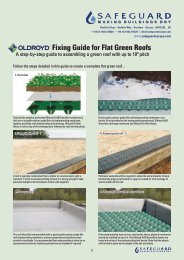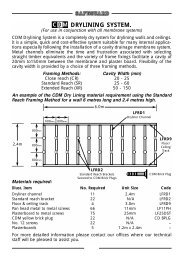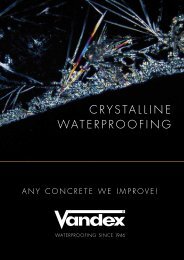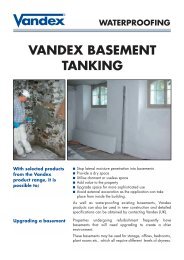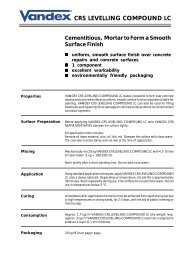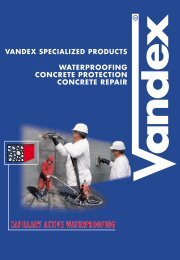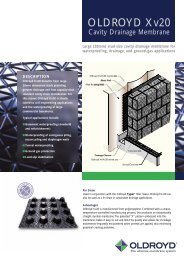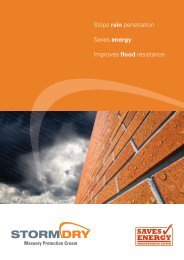A Guide to Condensation in Buildings - Safeguard Europe Ltd.
A Guide to Condensation in Buildings - Safeguard Europe Ltd.
A Guide to Condensation in Buildings - Safeguard Europe Ltd.
You also want an ePaper? Increase the reach of your titles
YUMPU automatically turns print PDFs into web optimized ePapers that Google loves.
A <strong>Guide</strong> <strong>to</strong> <strong>Condensation</strong><br />
The Problem<br />
<strong>Condensation</strong> is by far the most common cause<br />
of dampness <strong>in</strong> build<strong>in</strong>gs, probably account<strong>in</strong>g<br />
or most dampness problems reported. It affects<br />
both old and new properties, but it appears <strong>to</strong><br />
be a significant problem where the build<strong>in</strong>g has<br />
been modernised.<br />
<strong>Condensation</strong> is directly associated with mould<br />
growth, and it is this that the occupier first<br />
sees and gives an idea as <strong>to</strong> the potential scale<br />
of the problem. The mould is usually found on<br />
decorative surfaces, especially wallpapers,<br />
where it can cause severe and permanent<br />
spoil<strong>in</strong>g. The mould and its spores (‘seeds ’)<br />
cause the ‘musty ’ odour frequently associated<br />
with a damp house and can sometimes give<br />
rise <strong>to</strong> health problems.<br />
The obvious places or condensation <strong>to</strong> occur<br />
are on cold walls and floors, but sometimes it<br />
occurs <strong>in</strong> roof spaces and <strong>in</strong> subfloor areas<br />
where there is a suspended floor. Timbers <strong>in</strong><br />
these areas will become damp and susceptible<br />
<strong>to</strong> damage by dry rot or wet rot.<br />
The Cause<br />
It is a fact that warm air can hold more water<br />
as vapour than cool air. So, quite simply,<br />
condensation is caused when moisture-laden<br />
air comes <strong>in</strong><strong>to</strong> contact with a cold surface –the<br />
air is cooled <strong>to</strong> a po<strong>in</strong>t where it can no longer<br />
hold its burden of water vapour. At this po<strong>in</strong>t,<br />
(DEWPOINT), water beg<strong>in</strong>s <strong>to</strong> drop out of the<br />
air, and it is seen as condensation on surfaces.<br />
On impervious surfaces such as glass and<br />
pa<strong>in</strong>t, beads or a film of water collect, but on<br />
permeable surfaces such as wallpapered and<br />
porous plaster the condens<strong>in</strong>g water is<br />
absorbed <strong>in</strong><strong>to</strong> the material. Therefore, the<br />
problem is <strong>in</strong>itially not obvious.<br />
Recognis<strong>in</strong>g <strong>Condensation</strong><br />
<strong>Condensation</strong> is very much a seasonal<br />
problem, occurr<strong>in</strong>g dur<strong>in</strong>g the colder months<br />
(Oc<strong>to</strong>ber <strong>to</strong> April). Dur<strong>in</strong>g the summer the<br />
problem is seen <strong>to</strong> go away. Dur<strong>in</strong>g the w<strong>in</strong>ter,<br />
ventilation of the house is usually low<br />
(w<strong>in</strong>dows and doors are closed, draught<br />
proof<strong>in</strong>g takes place.) This allows build up of<br />
water vapour <strong>in</strong> the house, which, <strong>in</strong> some<br />
cases, is sufficient <strong>to</strong> cause condensation. So<br />
dur<strong>in</strong>g the colder months the follow<strong>in</strong>g signs<br />
beg<strong>in</strong> <strong>to</strong> appear:<br />
• Water droplets form on cold<br />
impervious surfaces such as glass<br />
and pa<strong>in</strong>t<br />
• Slightly damp wallpaper (often not<br />
noticed)<br />
• Development of moulds, usually black<br />
mould (Aspergillus niger). This<br />
frequently forms <strong>in</strong> areas where there<br />
is little air movement such as w<strong>in</strong>dow<br />
reveals, floor/wall and floor/ceil<strong>in</strong>g<br />
junctions, beh<strong>in</strong>d furniture aga<strong>in</strong>st<br />
colder walls and <strong>in</strong> the classic<br />
triangular pattern <strong>in</strong> corners. Where<br />
the problem is very severe, water will<br />
even collect and rema<strong>in</strong> on doubleglaz<strong>in</strong>g.<br />
In some cases, condensation may be long term<br />
but <strong>in</strong>termittent, form<strong>in</strong>g only at certa<strong>in</strong> times of<br />
the day or night. In these cases the only sign of<br />
condensation, may be mould growth, water<br />
perhaps evaporat<strong>in</strong>g dur<strong>in</strong>g the day. One<br />
should also be aware that the problem can<br />
occur well away from the site of most water<br />
vapour production. For example, water vapour<br />
produced <strong>in</strong> a kitchen may diffuse through the<br />
house <strong>in</strong><strong>to</strong> a cold bedroom where it will<br />
condense on cool walls and lead <strong>to</strong> mould<br />
growth.<br />
Confirmation<br />
If one wishes <strong>to</strong> confirm that there is a<br />
condensation risk, then a ‘Humiditect ’ card<br />
can be affixed <strong>to</strong> the surface where<br />
condensation is expected for at least 7 days<br />
(due <strong>to</strong> the <strong>in</strong>termittent nature of the problem).<br />
Spots of colour pr<strong>in</strong>ted on the card will
gradually ‘bleed’ <strong>in</strong><strong>to</strong> the card surround,<br />
depend<strong>in</strong>g on the severity of the problem.<br />
1. Levels of relative humidity encountered dur<strong>in</strong>g the<br />
exposure period are <strong>to</strong>o low <strong>to</strong> pose a condensation<br />
risk.<br />
Instructions for the use of Humiditect<br />
<strong>Condensation</strong> Indica<strong>to</strong>rs<br />
Humidtect Cards are a convenient and<br />
economic way of <strong>in</strong>dicat<strong>in</strong>g a condensation<br />
problem.<br />
1) Identify the area where you suspect<br />
moisture contam<strong>in</strong>ation is occurr<strong>in</strong>g.<br />
2) Open airtight sachet and remove the<br />
Humiditect card.<br />
2. Slight risk of condensation, but probably not<br />
enough <strong>to</strong> cause a problem.<br />
3) Fix the card <strong>to</strong> a wall us<strong>in</strong>g a p<strong>in</strong> or<br />
double-sided tape.<br />
4) Leave the Humiditect card <strong>in</strong> position<br />
for as long as possible <strong>to</strong> allow<br />
several potential phases of<br />
condensation <strong>to</strong> occur. We<br />
recommend seven days, but<br />
<strong>in</strong>dications can occur after two days.<br />
5) In severe cases of condensation,<br />
water may run down the wall. To<br />
prevent water contam<strong>in</strong>ation of the<br />
Humiditect surface, the card ’s <strong>to</strong>p<br />
edge should be bent forwards <strong>to</strong><br />
protect the <strong>in</strong>dica<strong>to</strong>r spots. After a<br />
period of 7 days some of the <strong>in</strong>dica<strong>to</strong>r<br />
spots will have started <strong>to</strong> ‘bleed ’or<br />
spread when a set Relative Humidity<br />
(RH)has been reached.<br />
6) (Relative Humidity is the amount of<br />
water vapour <strong>in</strong> the air at a given<br />
time) – The cards can be <strong>in</strong>terpreted<br />
as shown on the right:<br />
3. Considerable risk of condensation. It might occur<br />
on a regular basis and cause persistent<br />
dampness.<br />
4. Serious risk of condensation occurr<strong>in</strong>g on a<br />
frequent basis, sufficient <strong>to</strong> saturate the wall be<strong>in</strong>g<br />
tested.
The Solution<br />
The control of condensation, is based on two<br />
very simple primary measures supported by a<br />
number of secondary measures.<br />
Primary measures<br />
1) Improve ventilation<br />
This will disperse the <strong>in</strong>ternal<br />
moisture laden air and replace it with<br />
drier air from outside (yes, external air<br />
is drier than <strong>in</strong>ternal air most of the<br />
year!). Ventilation is achieved by<br />
open<strong>in</strong>g a few w<strong>in</strong>dows, <strong>in</strong>stall<strong>in</strong>g air<br />
vents, and us<strong>in</strong>g extrac<strong>to</strong>r fans.<br />
However, it is most effective <strong>to</strong><br />
remove the water vapour from where<br />
it is usually generated, e.g. kitchens<br />
and bathrooms. This is achieved by<br />
the <strong>in</strong>stallation of a powered extrac<strong>to</strong>r<br />
fan. Better still, rather than mak<strong>in</strong>g the<br />
occupant responsible for operat<strong>in</strong>g<br />
the fan, a humidistat controlled unit<br />
can be used. These activate when<br />
moisture levels <strong>in</strong> the atmosphere<br />
reach a po<strong>in</strong>t at which they may beg<strong>in</strong><br />
<strong>to</strong> cause a problem.<br />
Another approach, should<br />
condensation be widespread, is <strong>to</strong><br />
use a ‘positive pressure ’system such<br />
as the PPF9 Positive Pressure System<br />
available from <strong>Safeguard</strong>. This<br />
consists of a slow speed fan set <strong>in</strong><strong>to</strong><br />
the ceil<strong>in</strong>g. It draws air <strong>in</strong><strong>to</strong> the roof<br />
space from outside through the eaves,<br />
and gently pushes it <strong>in</strong><strong>to</strong> the property.<br />
This causes a slight <strong>in</strong>ternal positive<br />
pressure, cont<strong>in</strong>ually push<strong>in</strong>g out any<br />
moisture laden air as it develops. It is<br />
also important <strong>to</strong> promote free airflow<br />
around furniture, especially where it<br />
is aga<strong>in</strong>st cold walls. This will prevent<br />
a local build up of condensation/<br />
mould beh<strong>in</strong>d furniture.<br />
2) Heat<strong>in</strong>g<br />
Coupled with ventilation, heat<strong>in</strong>g<br />
should be set or applied <strong>to</strong> give a<br />
constant low-level background heat.<br />
This will ensure no rapid changes <strong>to</strong><br />
the environment, and will also<br />
facilitate slight warm<strong>in</strong>g of wall<br />
surfaces over a period of time thus<br />
reduc<strong>in</strong>g the risk of condensation.<br />
Secondary Measures<br />
In most cases, implement<strong>in</strong>g the primary<br />
measures described above will effectively<br />
control a condensation problem. However, <strong>in</strong><br />
more severe cases it may be necessary <strong>to</strong> use<br />
one or more of the follow<strong>in</strong>g support measures.<br />
1) Remove excess water sources<br />
This means remov<strong>in</strong>g systems with<strong>in</strong><br />
the house that generate excess water<br />
vapour. For example, bottled gas and<br />
paraff<strong>in</strong> heaters generate enormous<br />
amounts of water vapour. These alone<br />
may be responsible for the<br />
condensation. Further steps <strong>to</strong><br />
elim<strong>in</strong>ate water vapour <strong>in</strong>clude<br />
avoid<strong>in</strong>g the dry<strong>in</strong>g of clothes on, or<br />
by radia<strong>to</strong>rs and never vent<strong>in</strong>g a hot<br />
air clothes drier <strong>in</strong><strong>to</strong> the <strong>in</strong>terior of the<br />
property!<br />
2) Insulate cold surfaces.<br />
Some build<strong>in</strong>g materials have better<br />
thermal properties than others.<br />
3) Where solid walls are encountered<br />
(or cold solid floors) these may be<br />
<strong>in</strong>sulated by various dry l<strong>in</strong><strong>in</strong>g<br />
techniques or, <strong>in</strong> the least expensive<br />
case, the use of th<strong>in</strong> polystyrene<br />
sheet (Cot<strong>in</strong>a) applied directly <strong>to</strong> the<br />
wall. In all cases this will result <strong>in</strong> a<br />
warmer surface, thus lower<strong>in</strong>g the<br />
risk of condensation. It is also prudent<br />
<strong>to</strong> provide a vapour check on the<br />
warm side of the <strong>in</strong>sulation <strong>to</strong> prevent<br />
problems beh<strong>in</strong>d and deeper with<strong>in</strong><br />
the wall.<br />
4) Prevent possible water penetration<br />
Damp walls have poorer thermal<br />
properties than dry walls, and are<br />
therefore slightly cooler; this could<br />
<strong>in</strong>crease the risk of condensation.<br />
Water Repellents<br />
Treat<strong>in</strong>g the external faces of walls with<br />
silicone water repellent can help <strong>in</strong> some<br />
cases. This prevents water penetration thus<br />
ma<strong>in</strong>ta<strong>in</strong><strong>in</strong>g better thermal properties of<br />
external walls. <strong>Safeguard</strong> manufacture a range<br />
of Masonry Water Repellents under the brand<br />
names of ‘Ra<strong>in</strong>check Plus’ and ‘Ra<strong>in</strong>dance.’
Dehumidifiers<br />
These remove water from the atmosphere; they<br />
lower the water content of air, and therefore<br />
lower the risk of condensation. One<br />
strategically placed dehumidifier can be very<br />
effective.<br />
Mould growth:<br />
The greatest problem with long-term<br />
condensation is the associated mould growth,<br />
most frequently visible as black spot mould.<br />
Mould spores are present generally <strong>in</strong> the<br />
atmosphere, usually at relatively low levels.<br />
Under normal circumstances they cause no<br />
problem, surfaces be<strong>in</strong>g <strong>to</strong>o dry for their<br />
generation and growth. However, should they<br />
land on a wet surface (condensation)<br />
under humid conditions, then they will<br />
germ<strong>in</strong>ate and develop <strong>in</strong><strong>to</strong> heavy mould<br />
growth, with the <strong>in</strong>evitable release of vast<br />
numbers of spores. Not only does this cause<br />
decorative spoil<strong>in</strong>g, but, <strong>in</strong> some cases, health<br />
of occupants may also be affected.<br />
Published by:<br />
<strong>Safeguard</strong> <strong>Europe</strong> <strong>Ltd</strong>.,<br />
Redkiln Close,<br />
Redkiln Way,<br />
Horsham,<br />
West Sussex.<br />
RH13 5QL<br />
Tel: 01403 210204<br />
Fax: 01403 217529<br />
Email: <strong>in</strong>fo@safeguardeurope.com<br />
Web: www.safeguardeurope.com<br />
Note that Black Mould can only flourish on the<br />
pure water associated with condensation –<br />
Black Mould is NOT an <strong>in</strong>dication of RISING<br />
DAMP.<br />
Anti-mould washes will kill and remove the<br />
growth, but usually their effectiveness is short<br />
lived, as the active <strong>in</strong>gredient tends <strong>to</strong> get<br />
washed out over a period of time. Anti-mould<br />
pa<strong>in</strong>t should rema<strong>in</strong> effective for longer. Antimould<br />
scrubs and pa<strong>in</strong>ts are available from<br />
<strong>Safeguard</strong>.<br />
Anti Mould Pa<strong>in</strong>ts<br />
These are particularly useful where there is a<br />
high risk of mould growth, e.g. kitchens and<br />
bathrooms, and also where condensation is<br />
particularly difficult <strong>to</strong> control. They are applied<br />
like standard pa<strong>in</strong>ts, and must not be<br />
decorated over once applied. Good quality<br />
anti-mould pa<strong>in</strong>ts will rema<strong>in</strong> effective aga<strong>in</strong>st<br />
even the most severe mould growth conditions<br />
for over five years.<br />
©<strong>Safeguard</strong> <strong>Europe</strong> <strong>Ltd</strong>.


